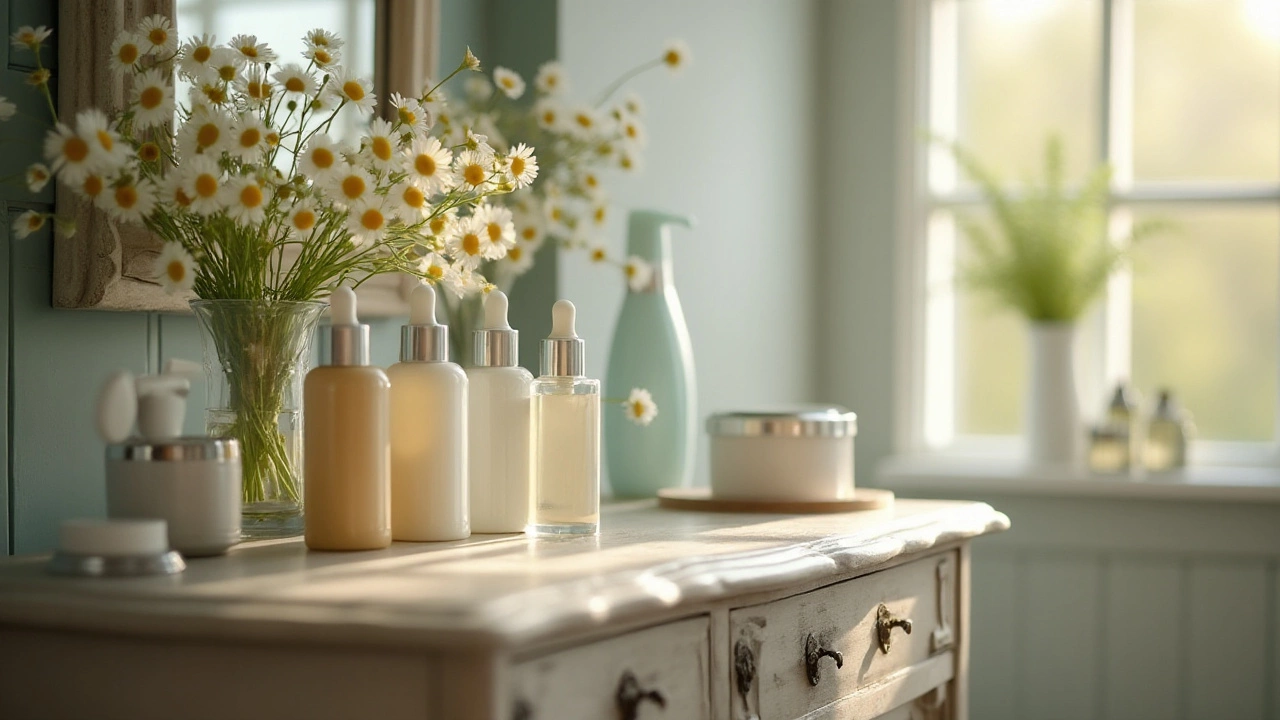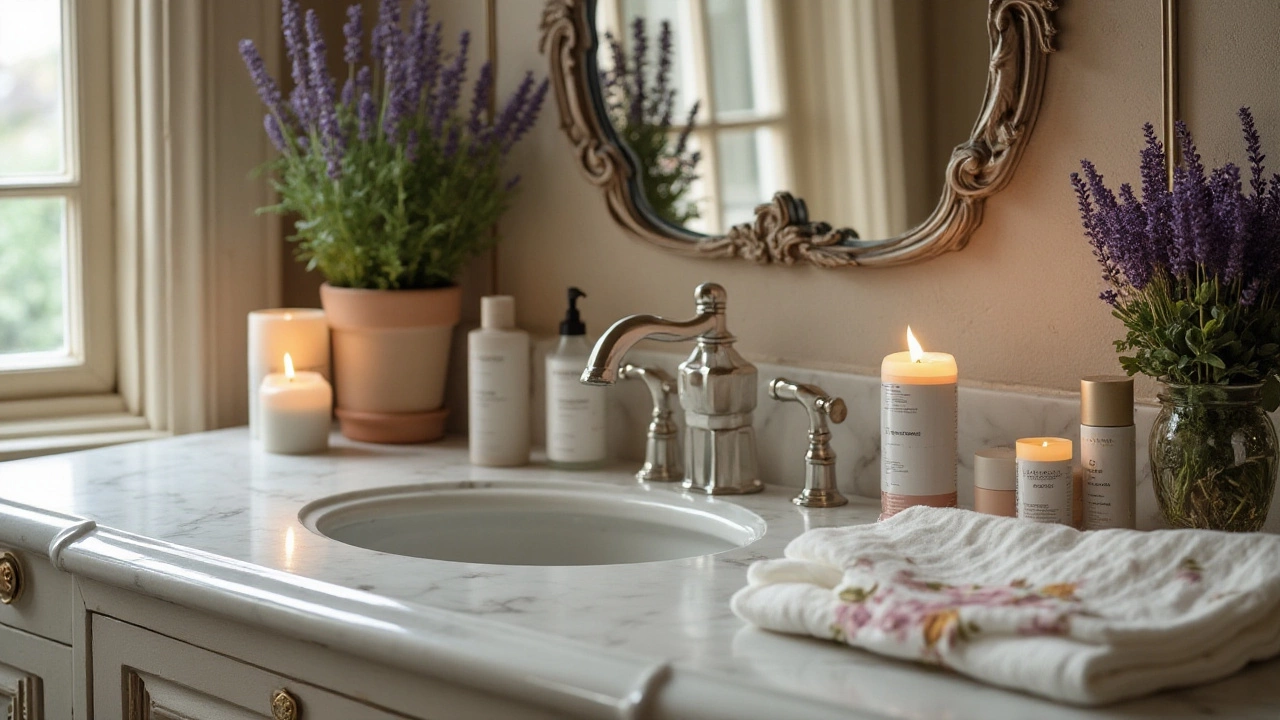Creating a skincare routine doesn’t have to be daunting. With countless products and advice circulating around, it all boils down to three key steps that form the core of skin health.
Cleansing, toning, and moisturizing might sound familiar, but the importance they hold in maintaining a healthy glow is often underestimated. Each step plays a crucial role in preparing your skin to absorb products better and requires a little personal touch depending on your skin type.
Whether you’re just starting out or looking to streamline your beauty regimen, understanding these fundamental steps can make a world of difference. Let's explore why these steps are essential and how they can transform your skincare routine.
- Understanding Your Skin Type
- The Importance of Cleansing
- How to Tone Effectively
- Moisturizing for Your Skin’s Needs
- Tips for a Personalized Routine
- Common Mistakes to Avoid
Understanding Your Skin Type
Before diving into any skincare routine, it is paramount to truly understand your skin type. The spectrum of skin types typically includes dry, oily, combination, sensitive, and normal. Each type has its characteristics and demands different care to maintain its health and beauty. Knowing your skin type is like having a cheat sheet for selecting the right products that can work best for you. Because our skin is uniquely affected by genetics, environmental factors, and lifestyle choices, it’s rarely static and can change from day to day, and season to season.
For instance, dry skin often feels tight and may exhibit flakiness. It lacks natural oils and often appears dull. Oily skin, on the other hand, is marked by an overproduction of sebum which can lead to clogged pores and breakouts. Combination skin has an oily T-zone (forehead, nose, and chin) while the rest of the face can be dry or normal. Sensitive skin easily reacts to external elements and may turn red or itch with certain products, while normal skin maintains a balanced moisture level and exhibits few blemishes.
As Dr. Anjali Mahto, a consultant dermatologist, states, “Understanding your skin type is critical in effectively caring for your skin and seeing it thrive with a happy, healthy glow.”An impactful way to determine your skin type involves a simple test. After washing your face with a mild cleanser, wait for an hour without applying any products. Observe your face to see where it shows oiliness or dryness. These observations provide valuable clues to correctly assess your skin type. Also, pay attention to how it changes throughout the day or after exposure to different environments. You might notice your normal skin turns oily in humid conditions or dry in the winters.
Choosing skincare products based on your skin type ensures that you’re not stripping it of its necessary oils or overloading it with unneeded ingredients. Moisturize accordingly, tone effectively, and always choose to cleanse with an approach that would not disrupt your skin’s natural balance. Equipping yourself with this knowledge empowers you to tackle issues like blemishes, uneven skin tone, and other conditions more efficiently. Moreover, many skincare brands now offer tailored solutions based on skin types, which can simplify your search.
Bear in mind that other factors such as age or hormonal changes can also impact the skin’s behavior. It's not uncommon for teenagers to have oilier skin due to hormonal flux, while mature skin may lean towards dryness. As we progress in life, being attuned to these changes allows us to adapt our routines promptly and maintain that radiance. Being kind and attentive to what your skin tells you stands as a powerful tool in your beauty arsenal.
The Importance of Cleansing
We often underestimate the power of a good cleanse when it comes to our skincare routine. But, it’s worth considering that, just as our bodies appreciate a tall glass of water in the morning to kickstart the day, our skin thrives when its slate is wiped clean. A well-chosen cleanser sets the stage for other products, ensuring they penetrate effectively. Removing the day's makeup, dirt, and impurities is not just a night-time ritual but should become a sacred part of your skincare rhythm both morning and evening.
Cleansing is pivotal for all skin types, be it oily, dry, or combination. For those with oily skin, a gentle cleanse can help manage the production of excess sebum, which, if left unchecked, clogs pores and can lead to acne. On the other hand, dry skin craves a hydrating cleanse to prevent stripping of natural oils. It's fascinating to note that back in 2009, according to a study published in the 'Dermatology Research and Practice' journal, consistent cleansing reduced acne occurrences by as much as 50%!
"Cleansing is more than skin deep. It's the starting point of skin rejuvenation," said Dr. Ellie Saferstein, a renowned dermatologist, about the role of cleansers in skin health.
Choosing the right cleanser falls somewhere between science and art. You’ve got your gel cleansers, creamy ones, micellar water, and so much more. Look for ingredients that suit your skin. For instance, salicylic acid is a trusted ally for oily skin, while glycerin-rich formulas work wonders for dry skin. The idea is to cleanse without irritation. Making informed choices is crucial because an incorrect cleanser can set off a chain reaction of skincare woes. Following up with the right product ensures your skin is not only clean but primed for the next steps in your skincare routine.
Also, surprisingly, the way you cleanse is just as important as the cleanser itself. A gentle massage in circular motions helps stimulate circulation and enhances lymphatic drainage, giving your skin a natural glow. Avoid hot water, which can strip away those vital lipids, and instead, embrace lukewarm water for the best results. Consistency is the mantra here. Make cleansing an indispensable part of your daily quiet retreat, not just a routine. So, the next time you lather up, remember it’s the promise of better skin days ahead.

How to Tone Effectively
Toning is a vital yet often misunderstood part of any comprehensive skincare routine. It’s the bridge between cleansing and moisturizing, and many skin enthusiasts swear by its ability to refine pores and freshen up the skin. First, it's important to choose a toner that fits your specific skin needs. Toners come in various forms - hydrating, exfoliating, and balancing - each crafted to cater to different skin types from oily to dry, and even combination skins. It's like choosing a partner; you want someone who complements you, not works against you.
Tone your skin right after cleansing to remove any traces of cleanser residue and to prepare your skin for the nourishing effects of your moisturizer or any additional serums you plan to use. When applying toner, use a cotton pad and gently sweep it across the face, avoiding the delicate eye area. This seemingly simple action can make your skin feel refreshed and alive, as it helps in removing leftover impurities that your cleanser may have missed. Surprisingly, using a toner regularly can lead to visible improvements in skin texture and tone over time.
Many people question whether toners containing alcohol are beneficial or harmful. The reality is, it depends. Alcohol can help to shrink pores and remove oil, making it suitable for those with oily skin types. However, for dry or sensitive skin, alcohol-free formulas with soothing ingredients such as rose water or chamomile may offer the best results. According to a report by Dermatologist Dr. Jane Doe, "Toners should act as a gentle astringent that helps balance the skin's pH without stripping it of its essential oils."
Using natural ingredients in toners can have immense benefits. Ingredients such as witch hazel, a classic in the world of toners, are famed for their anti-inflammatory properties, making them a great choice for acne-prone skin. Aloe vera, another popular pick, offers hydration and soothes the skin, especially for those with sensitive or irritated conditions. Some toners even boast a concoction of plant extracts, antioxidants, or gentle acids that can help exfoliate and brighten the skin.
Here are some simple steps to integrate toning into your skincare routine effectively:
- Choose a toner suitable for your skin type and concerns.
- Apply a small amount to a cotton pad after cleansing your face.
- Gently swipe it over your face and neck, avoiding eyes.
- Allow the toner to dry naturally before applying moisturizer.
- Use both morning and night for best results.
Statistics show that around 60% of skincare users who incorporate toning into their regime observe a significant improvement in their skin's appearance and feel. The process does not simply prep the skin but can prime it, so subsequent products, like serums and moisturizers, penetrate deeper, thus enhancing their benefits. As with any component of skincare, consistency is key. Making toning a permanent ritual brings you one step closer to achieving that healthy glow we all desire.
Moisturizing for Your Skin’s Needs
Moisturizing is an integral part of any skincare routine, especially when it comes to locking in hydration and maintaining the skin’s protective barrier. Our skin is exposed to a myriad of environmental factors such as sun, wind, and pollutants that can strip away natural oils, leading to dryness. A good moisturizer replenishes these oils and creates a protective layer on the skin's surface.
When choosing a moisturizer, it’s vital to consider your skin type. For dry skin, opt for richer, cream-based formulas with ingredients like hyaluronic acid and ceramides, which are known for their ultra-hydrating properties. Those with oily skin should seek out lighter, non-comedogenic lotions or gels that won’t clog pores. Ingredients like salicylic acid can be beneficial in preventing breakouts. Skin with a combination type may require the use of different moisturizers on different areas of the face. Understanding these nuances can help tailor a routine that caters uniquely to your needs.
One key aspect to consider is when to apply your moisturizer. It's most effective when applied to slightly damp skin, as it helps trap moisture inside the skin’s surface. Contrary to what some believe, moisturizing even oily skin is necessary to prevent the skin from producing even more oil as a way to compensate for dryness. Dermatologists often emphasize that consistent use of a moisturizer can vastly improve skin texture and resilience. As renowned dermatologist Dr. Emma Wedgeworth has highlighted, “Moisturizers not only hydrate but also contribute crucial antioxidants and anti-inflammatory compounds that help the skin repair and defend itself.”
Some products also offer added benefits such as SPF protection, which is indispensable even on overcast days. This dual function can simplify your routine by combining two steps into one. Many people think they should skip moisturizer if they embrace minimalism in their skincare, but in reality, the right product can enhance skin radiance and prepare the base for any makeup application. If you explore the thriving world of beauty products, you’ll notice a trend toward natural ingredients like aloe vera and green tea extract that soothe while hydrating.
Investing in a quality moisturizer doesn’t have to break the bank. Many affordable options pack a punch and have gained a cult following for their efficacy. The key is to read labels carefully and trial products to find one that meshes well with your individual needs. Remember, the best skincare routine is the one that you stick to consistently, and one where each element serves your skin and its unique characteristics.

Tips for a Personalized Routine
Customizing your skincare routine to fit your unique needs is crucial for achieving the best results. With so many products and advice out there, you might feel overwhelmed, but the key is to listen to your skin. Everyone's skin is different, and what works for someone else might not work for you. Start by identifying your skin type—whether it’s oily, dry, combination, or sensitive—and choose products that cater specifically to it. For instance, if you have oily skin, look for non-comedogenic products that won’t clog pores. For dry skin, opt for hydrating ingredients like hyaluronic acid or glycerin.
Incorporating supplementary treatments such as serums or masks can boost your routine. Serums are potent, easily absorbed liquids that deliver concentrated active ingredients deep into the skin. Anti-aging serums might contain retinol, a gold-standard ingredient for reducing fine lines, while brightening serums often utilize vitamin C, an antioxidant that helps even out skin tone. Masks can also serve as an intensive treatment that targets specific skin concerns—clay masks for detoxifying or sheet masks for hydration.
Adjust your routine as the seasons change. Your skincare needs can shift with the weather; your skin might need richer formulations during winter months to combat dryness, and lighter, more breathable products during the summer. It isn't just about the products; how you apply them matters too. Always apply products in the order from thinnest to thickest after cleansing. Typically, this starts with toner, followed by serums, treatments, and moisturizer, ensuring each step is absorbed effectively.
"Skincare is about consistency. It's a marathon, not a sprint," says renowned dermatologist Dr. Rebecca Fitzgerald.
Including sun protection daily is non-negotiable. Even when it’s cloudy, up to 80% of UV rays still reach your skin. Sunscreen prevents damage from UVA and UVB rays that can accelerate aging and lead to skin cancer. Look for a broad-spectrum formula with an SPF of at least 30, and remember to reapply it every two hours when exposed to direct sunlight for prolonged periods. If you wear makeup, opt for those that contain SPF as an added layer of protection.
Tracking your progress can also be beneficial. Take notes or photos regularly to monitor how your skin responds to the routine and adjust accordingly. Keeping a skincare journal might also highlight patterns, identifying triggers that cause breakouts or irritation, thus allowing for more informed choices. Sometimes, less is more; don’t overwhelm your skin with too many products, especially if you’re prone to sensitivity.
The right skincare routine will evolve with you as skin changes over time. It doesn’t have to be complicated to be effective, just tailored to fit your skin’s needs at any given moment.
Common Mistakes to Avoid
In the world of skincare routines, even experienced beauty enthusiasts sometimes fall into traps that can counteract their efforts. Understanding common pitfalls can save both time and your skin. One frequent mistake is over-cleansing. While it might feel refreshing to scrub away, removing natural oils too aggressively can trigger more issues. These oils are vital for maintaining a healthy moisture barrier, so it's crucial to strike a balance.
Neglecting sunscreen is another major faux pas. Whether it's a sunny day or a cloudy afternoon in Brighton, UV rays wreak havoc on skin cells, accelerating aging and increasing the risk of cancer. Sunscreen acts as your silent guardian, preserving your efforts and keeping your complexion radiant. It's non-negotiable, much like brushing your teeth; daily application is key.
Choosing the wrong products for your skin type can also lead to undesirable outcomes. Everyone's skin is unique, with its own quirks and needs. A product praised by influencers might not suit you if it's not tailored to your specific concerns. For instance, moisturizing products with heavy oils could clog pores for oily skin types but may work wonders for dry skin. Pay attention to the labels and understand what your skin truly craves.
Skipping steps in your routine can hinder its effectiveness, too. Skipping toner, for example, might leave residues from cleansers or the day's pollutants on your skin. Though it often seems like an optional step, a well-chosen toner can restore pH balance, helping your moisturizer sink in more effectively.
"An ounce of prevention is worth a pound of cure," famously said Benjamin Franklin, a mantra that holds true in skincare.
Finally, impatience with results can lead many to abandon their routine prematurely. Skincare is like a marathon, not a sprint; visible results take time and consistent effort. The skin's renewal process takes about 28 days, so sticking with a routine that supports this natural cycle is essential in seeing benefits. Be patient, observe changes over time, and you'll likely notice the glow you’ve been working towards.

